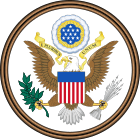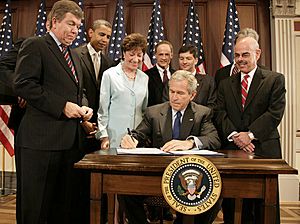Federal Funding Accountability and Transparency Act of 2006 facts for kids
 |
|
| Long title | A bill to require full disclosure of all entities and organizations receiving Federal funds. |
|---|---|
| Acronyms (colloquial) | Federal Funding Accountability and Transparency Act of 2006 |
| Enacted by | the 109th United States Congress |
| Citations | |
| Public law | Pub.L. 109-282 |
| Statutes at Large | 120 Stat. 1186 |
| Legislative history | |
|
|
The Federal Funding Accountability and Transparency Act of 2006 (often called FFATA) is a special law passed by the United States Congress. This law makes sure that the public can see where all government money goes. It requires that all groups or organizations receiving money from the federal government must share this information. This started in the 2007 financial year.
As a direct result of this law, a website called USAspending.gov was launched in December 2007. This website is managed by the Office of Management and Budget (OMB), which helps the President manage the federal budget. The Congressional Budget Office, a group that estimates costs for laws, thought this act would cost about $15 million between 2007 and 2011.
This important bill was first suggested by Senator Tom Coburn. He worked with Senators Barack Obama, Tom Carper, and John McCain. They introduced the bill on April 6, 2006. After some delays, it was approved by everyone in the Senate on September 6, 2006. The House of Representatives also passed it on September 13, 2006. Finally, President George W. Bush signed it into law on September 26, 2006.
In 2008, Senator Obama and others introduced a new law. It was called the Strengthening Transparency and Accountability in Federal Spending Act of 2008. This new law aimed to make government spending even more clear.
Contents
What the Act Requires
This law makes sure that a single, easy-to-use website exists. This website, USAspending.gov, is free for anyone to use. It must show details for every time the government gives out money.
Key Information on the Website
The website needs to show several important things about each payment:
- The name of the group or person getting the money.
- The exact amount of money they received.
- Details about the payment, like what kind of payment it is. It also shows which government agency gave the money.
- Where the group getting the money is located. This includes the city, state, and even the country. It also shows where the work for the money is being done.
- A special ID number for the group getting the money. If that group is owned by a bigger company, the website also shows the ID for the parent company.
- Any other important information that the Office of Management and Budget decides is needed.
Who Supported the Bill
Besides Senators Coburn, Obama, Carper, and McCain, many other senators also supported this bill. In total, 43 other senators helped to sponsor it. This showed that the bill had strong support from both major political parties.
How the Law Was Made
The process of making this bill into a law had strong support from both Republicans and Democrats. This is called bipartisan support.
Journey Through the Senate
The bill, known as S. 2590, started in the Senate on April 6, 2006. It was then sent to a special committee that deals with government money. Hearings were held in July 2006, where people discussed the bill. An update was added to the bill on July 27, 2006.

On August 31, 2006, the Senate leader, Bill Frist, said the bill would be voted on in September. On September 7, 2006, the Senate passed the bill by unanimous consent. This means every senator present agreed to it.
Passing in the House
The bill then moved to the House of Representatives on September 8, 2006. Just five days later, on September 13, 2006, the House passed it by a voice vote. This means members said "aye" or "no" out loud, and the speaker decided which side had more votes.
Dealing with "Secret Holds"
At one point, two senators, Ted Stevens (a Republican) and Robert Byrd (a Democrat), put "secret holds" on the bill. A "secret hold" is a special rule in the Senate. It lets a senator stop a bill from being voted on without anyone knowing who did it.
Senator Coburn eventually told the public that Senator Stevens was blocking the bill. After this, many people, especially on political websites and blogs, started asking their senators if they had placed a hold. This effort was a rare example of different political groups working together online.
After public pressure, Senator Stevens confirmed he had placed a hold. Senator Byrd also admitted to a hold, saying he needed more time to review the bill. Both senators eventually removed their holds, allowing the bill to move forward.
President's Final Approval
President George W. Bush signed the bill into law on September 26, 2006. Many important people were there for the signing. This included Senator Tom Coburn, who wrote the bill, and Senator Barack Obama, who helped a lot with it.
How the Act Was Put into Action
The law gave the Office of Management and Budget (OMB) the job of creating the new website. Around the time the law passed, a group called OMB Watch was already working on a similar website. This group helps keep an eye on government activities.
Gary Bass, the head of OMB Watch, offered to help the OMB create the new government website. Even though OMB Watch often criticized the OMB, they decided to work together. The government's website, USASpending.gov, ended up being based on what OMB Watch had developed.
By early 2008, the government's site offered the same information as OMB Watch's site, fedspending.org. In 2017, the Secretary of the Treasury, Steven Mnuchin, announced that the site had been updated. This update made it even easier to see how the government spends its money.

